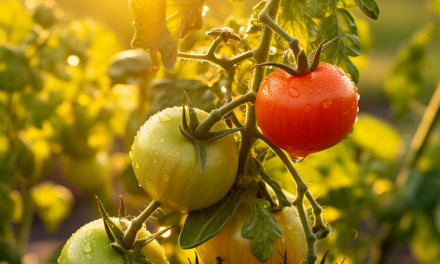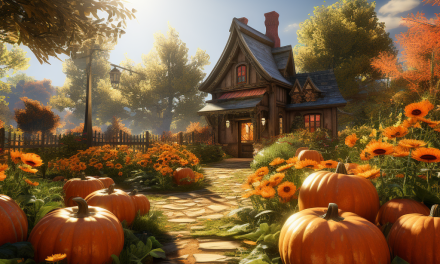A Garden is More Than Just Plants; It’s a Journey
Hello, lovely readers! I’m Gayle the Gardener, and if you’re reading this, it’s probably because you’ve been bitten by the gardening bug—or at least you’re flirting with the idea. So, why garden? Well, let me tell you, gardening is not just about putting plants in the ground. It’s a transformative experience that connects you with the earth, challenges your patience, and rewards you in blooms, aromas, and sometimes, delicious produce. It can be an oasis of calm, a practical source of herbs and veggies, or simply a riot of colors to brighten your space. But before you dive into this incredibly fulfilling hobby, it’s crucial to have a solid understanding of the Beginner’s Gardening Guide.
There’s a saying among us gardeners: “The first year they sleep, the second year they creep, and the third year they leap.” This applies to both plants and newbie gardeners. You might not see the fruits of your labor immediately, but with the right foundation, you’ll soon see your garden—and your confidence—flourish. Trust me, you’ll want to have your basics right before you dive into this lifelong affair with the soil and greens. It’s a bit like cooking; you could wing it, but wouldn’t you rather go in with some know-how and come out with something truly amazing?
🌱 Pro-Tip: If you’re just starting, don’t overwhelm yourself. Start small—a single potted plant or a small flower bed can teach you more than you think.
Now, I could go on and on about why gardening is my ultimate form of self-care, how it literally grounds me (pun intended), and why I believe it could do the same for you. But let’s get our hands a little dirty, shall we?
And let’s make this clear: Whether you’ve never touched a trowel in your life or have some experience but want to up your game, there’s something in this guide for everyone. So grab your gardening gloves, because we’re about to delve deep into the earthy, wonderful world of gardening.
Ah, the joy of seeing that first sprout emerge from the soil, or the thrill of harvesting your own home-grown tomato—these are the simple pleasures that await you. So let’s embark on this green journey together. It’s going to be a beautiful ride!
In this enriching guide, you’re not just learning to garden; you’re learning to cultivate a more balanced, harmonious life. I’m thrilled you’re here, and I can’t wait to share this wealth of earthly wisdom with you.
Preparing Your Garden Space—Where the Green Dreams Begin
Ah, the excitement of starting a new garden! It’s tempting to dash out and buy the first pretty plants you lay eyes on. But let’s pump the brakes a bit. Your garden, like any good story, needs a well-thought-out setting. You wouldn’t build a house without first preparing the land, would you? Likewise, before you start planting, you need to prepare your garden space.
The Layout Matters
Firstly, have a look at the space you have available. It doesn’t have to be huge; even a small balcony can be transformed into a delightful green haven with the right planning. Now, walk around your chosen area at different times of the day. Notice how the sunlight shifts? Some plants love sunlight, while others prefer the shade. Knowing the light patterns will guide your plant choices.
🌱 Pro-Tip: You don’t need a vast estate. Containers, hanging pots, or vertical gardens are excellent for limited spaces. With the right strategy, you can make the most of any area, no matter how small!
Sunlight & Shade: Know Your Zones
Another crucial aspect of preparing your garden space is understanding the amount of sunlight and shade it receives. Most plants require at least 6 to 8 hours of direct sunlight, but some are quite content with partial shade. Label different parts of your garden as high sun, partial shade, or low sun areas. This simple act can help you significantly in plant selection and placement.
🌱 Pro-Tip: Use a sun calculator app on your smartphone. It’s an easy and accurate way to measure light levels in your garden.
Soil: The Foundation of Your Garden
Ah, soil—the unsung hero of every successful garden. If your garden were a cake, the soil would be the flour. It’s the base of everything, and its quality can make or break your gardening efforts. But worry not, understanding soil is not as daunting as it sounds. You’ll need to get a little dirty, but hey, that’s what gardening is all about!
Types of Soil: A Quick Rundown
Soil comes in different types—sandy, loamy, and clay. Each has its own set of pros and cons. Sandy soil drains well but doesn’t hold nutrients. Clay soil is nutrient-rich but has poor drainage. Loamy soil? That’s the gold standard: it has good drainage and holds nutrients well.
🌱 Pro-Tip: Perform a quick jar test at home to determine your soil type. Fill a jar with soil and water, shake it well, and let it settle. Sandy soils will settle quickly, clay will take longer, and loamy will be somewhere in between.
That’s a lot to take in, isn’t it? But don’t fret. The joy of gardening comes from learning, making small mistakes, and growing—both metaphorically and literally. So let’s continue this green odyssey and cultivate not just plants, but also our understanding of the world beneath them.
Tools of the Trade—Your Trusty Companions in the Garden
So, you’ve decided on your garden’s layout and are familiar with its soil—great strides indeed! Now comes the next exhilarating chapter in your gardening journey: equipping yourself with the right tools. Just like a painter needs brushes and a chef needs knives, a gardener’s vision comes to life through their tools.
The Basics: Your Gardening Starter Kit
You don’t need to break the bank to get started. A few essential items will go a long way. Here’s what you absolutely can’t do without:
Trowels: For digging small holes, breaking up earth, and planting.
Gloves: A good pair can save your hands from thorns, splinters, and yes, even creepy-crawlies.
Watering Can or Hose: Depending on your garden size, one of these will be necessary for regular watering.
Pruning Shears: For snipping away dead leaves or errant branches and helping your plants grow strong and healthy.
Garden Fork: Useful for turning soil and breaking up particularly stubborn lumps.
🌱 Pro-Tip: Invest in tools with ergonomic handles. Your future self, free of wrist and backaches, will thank you!
The Extras: Nice to Have, But Not Essential
Once you’ve gotten the hang of it, there are additional tools that can make your gardening journey smoother and more enjoyable:
Wheelbarrow: Perfect for transporting soil, compost, or even heavy plants from point A to point B.
Soil pH Meter: If you’re really committed, measuring your soil’s pH can help you tailor your fertilizer and watering regime.
Garden Hoe: Excellent for shaping the soil and removing weeds.
Plant Markers: They can be as simple as popsicle sticks but are invaluable for remembering what you’ve planted where.
🌱 Pro-Tip: As you expand your toolshed, keep in mind: quality over quantity. A well-made tool can last you a lifetime!
There’s a unique satisfaction in holding a tool and knowing it’s your gateway to creating something beautiful. Each tool has its purpose, its role in shaping your garden. And much like how each plant adds to the garden’s overall beauty, each tool contributes to making your gardening experience as fruitful as possible.
So go ahead, equip yourself with these faithful companions and prepare to get your hands dirty. You’re not just crafting a garden; you’re crafting a sanctuary, a personal Eden built on sweat, love, and perhaps a few gardening gloves.
Picking Your Plants—The Stars of Your Garden
Ah, the moment you’ve been eagerly waiting for—choosing the plants that will grace your garden with their presence. This is where your personal touch truly shines through, making your garden uniquely yours. However, before you get carried away by the beautiful blooms or the mouth-watering vegetable plants at the nursery, let’s set the stage for success.
Know Your Zone
One of the first things to consider when choosing plants is your USDA Hardiness Zone. This zone map tells you which plants are most likely to thrive in your specific location. It’s a simple yet effective way to narrow down your choices and set yourself up for success right from the start.
🌱 Pro-Tip: While the hardiness zone provides a great starting point, also consider other local factors like soil quality, wind patterns, and available light when choosing plants.
Annuals vs. Perennials: The Lifecycles of Plants
There are primarily two types of plants you’ll come across:
Annuals: These are the plants that complete their lifecycle in one season. They grow, bloom, and produce seeds all in one go. Think marigolds, petunias, and most vegetables.
Perennials: These plants stick around for the long haul, coming back year after year. Examples include lavender, rosemary, and daylilies.
Both have their merits and drawbacks, and most gardens benefit from a mix of the two.
🌱 Pro-Tip: Annuals generally offer more vibrant colors and are great if you like changing your garden’s look frequently. Perennials require less replanting but might take more time to establish and bloom.
Food or Foliage? Why Not Both?
While flowering plants add a burst of color and aesthetic appeal, don’t overlook the practicality of growing your own fruits, herbs, and vegetables. Nothing beats the taste of a tomato straight from the vine or basil snipped fresh from your herb patch.
🌱 Pro-Tip: Many herbs like rosemary and basil are not only useful for cooking but also add a delightful fragrance to your garden. Plus, they’re generally easy to care for, making them great choices for beginners.
Suit Your Style
Whether you’re going for a cottage garden full of blooms or a minimalist Zen garden, the plants you choose should reflect your personal style and the atmosphere you want to create. Don’t be afraid to experiment and try new things. After all, gardening is as much about the journey as the destination.
🌱 Pro-Tip: Keep a gardening journal. Note down what you plant, where you plant it, and how it grows. This will be incredibly helpful in planning your garden year after year.
By taking the time to thoughtfully select your plants, you’re not just filling your garden with greenery; you’re curating a collection of living, breathing organisms that will grow alongside you. Each leaf, each petal, each root is a testament to the love and care you’ve poured into your slice of paradise.
Cultivating Success—Ongoing Care and Maintenance
So, you’ve rolled up your sleeves, gotten down in the dirt, and now have your plants snugly in their new homes. A job well done! But don’t hang up those gardening gloves just yet. The act of planting is merely the first step in a rewarding, ongoing relationship with your garden. Much like any meaningful relationship in life, it requires care, attention, and sometimes, a bit of troubleshooting.
Watering: More Than Just H2O
Watering might seem like the most straightforward task, but it’s a nuanced dance that varies from plant to plant. Some like their soil to be consistently moist, while others prefer it on the dry side.
🌱 Pro-Tip: Early morning or late afternoon is often the best time to water your plants, as this helps minimize evaporation. Also, water at the base rather than overhead to prevent disease.
Feeding Your Green Friends
Even the richest soil will eventually become depleted of nutrients as your plants grow and flourish. A well-timed application of fertilizer can make a world of difference.
Synthetic Fertilizers: Quick and highly effective, but can be harsh on the soil and its microbial life.
Organic Fertilizers: Slower to release nutrients, but they improve soil quality over time.
🌱 Pro-Tip: Use a slow-release organic fertilizer for perennial plants. They’ll appreciate the consistent nutrient supply.
Pest Management: A Delicate Balance
Pests are an inevitable part of the gardening experience, but that doesn’t mean you’re powerless. There are plenty of ways to manage them without resorting to harmful chemicals:
Biological Control: Introduce natural predators like ladybugs.
Mechanical Control: Use barriers or traps to physically remove or deter pests.
Cultural Practices: Crop rotation, proper spacing, and sanitation can greatly reduce pest problems.
🌱 Pro-Tip: Sometimes, the best pesticide is a keen eye. Regularly inspect your plants for early signs of infestation.
Pruning and Deadheading
As your plants grow, some housekeeping is in order. Pruning helps shape the plant, promotes air circulation, and encourages new growth. Deadheading—removing spent blooms—encourages the plant to focus its energy on new growth.
🌱 Pro-Tip: Always use clean, sharp pruning shears to make clean cuts. This minimizes stress and disease.
Remember, gardening isn’t a set-it-and-forget-it endeavor. It’s an evolving, dynamic process that changes from day to day, season to season. It asks for your attention but rewards you with a lush, thriving garden, filled with colors, fragrances, and perhaps a tasty fruit or herb to enjoy.
Through the Seasons—Preparing Your Garden for the Year Ahead
Ah, the ever-changing tapestry of seasons—each one with its own unique set of challenges and delights. Gardening is not a hobby confined to the balmy days of spring and summer; it’s a year-round endeavor. Your garden, much like you, adapts and changes, and it needs your guidance through the seasonal shifts.
Spring: The Season of New Beginnings
Spring is often the most exciting time for gardeners. The earth wakes up from its winter slumber, and it’s time to start planting.
Clear Debris: Remove any leaves, twigs, or other debris from your beds.
Soil Testing: Revisit your soil’s pH and nutrient levels, adjusting as necessary.
Start Planting: Early spring is the time for hardy vegetables and some flower varieties.
🌱 Pro-Tip: Spring is also a great time to divide perennials. This not only keeps them healthy but gives you free plants to spread around or share!
Summer: The Bloom and the Heat
Summer brings its own set of tasks. The garden is in full swing, and it’s crucial to keep up with maintenance.
Watering: Hotter weather means more frequent watering, but remember, always water deeply and less often as opposed to shallow and frequent.
Mulching: Add a layer of mulch to keep the soil cool and reduce water evaporation.
Harvest: Enjoy the fruits (and vegetables and herbs) of your labor!
🌱 Pro-Tip: Summer is an excellent time to take stock and plan. Take note of what’s thriving and what’s not, so you can make informed choices next year.
Autumn: Preparing for Rest
As the leaves change color and the air gets crisp, it’s time to prepare your garden for winter.
Clean Up: Remove any spent plants and compost what’s not diseased.
Soil Amendments: Add any needed compost or organic matter and consider cover crops to protect the soil.
Winterizing: Protect sensitive perennials with mulch or burlap wraps.
🌱 Pro-Tip: Fall is the best time for planting trees and shrubs. The soil is still warm, allowing roots to establish before winter.
Winter: The Quiet Time
While your garden may look dormant, there’s still work to do!
Planning: Use this time to plan next year’s garden, taking into account what worked and what didn’t this year.
Tool Care: Clean, sharpen, and oil all your tools so they’re ready for spring.
Indoor Gardening: If you miss getting your hands dirty, consider small indoor plants or even a windowsill herb garden.
🌱 Pro-Tip: Use winter downtime to research and learn. Maybe there’s a new gardening technique or a plant you’ve never heard of. Knowledge is power, and winter provides ample time to empower yourself.
As you can see, every season brings its own set of responsibilities and joys. Your garden, this wonderful living entity, goes through cycles just like any other living being. But worry not, for with each season that passes, you’ll find yourself becoming more attuned to its needs, more in sync with its rhythms, and more capable of meeting its challenges head-on.
And there we have it—a full cycle of gardening wisdom, from the first shovel of soil to the changing leaves of autumn. The world of gardening is as vast as nature itself, but I hope this guide has provided you with a solid foundation on which to build your own garden sanctuary. After all, the best garden is the one that you cultivate yourself, with love, care, and a touch of the wild spirit that makes every garden truly magical.
Amazon and the Amazon logo are trademarks of Amazon.com, Inc, or its affiliates.AMAZON AFFILIATE DISCLOSURE The Garden Whisperer Tips blog is a participant in the Amazon Services LLC Associates Program, an affiliate advertising program designed to provide a means for sites to earn advertising fees by advertising and linking to Amazon.com. As an Amazon Associate, we earn from qualifying purchases. Some of the links on this blog are affiliate links, and if you go through them to make a purchase, we will earn a commission at no extra cost to you. AFFILIATE MARKETING AND ADVERTISEMENT TRANSPARENCY At Garden Whisperer Tips, we believe in full transparency with our readers. We participate in multiple affiliate marketing programs, and some of the links on this blog may be affiliate links. This means we may earn a commission if you click on the link or make a purchase using the link. We also host advertisements on our blog, which helps us generate revenue. Rest assured, our editorial content is not influenced by advertisers or affiliate partnerships.





